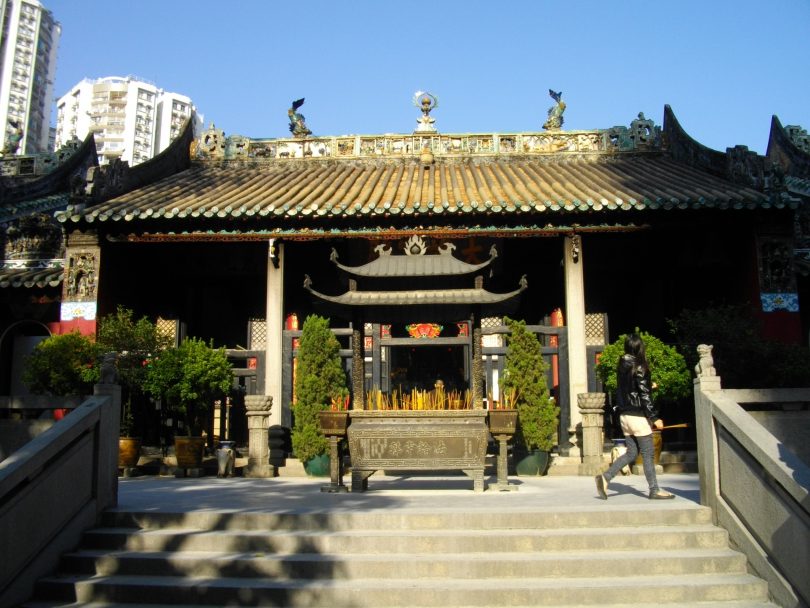This article first appeared in the Jul/Aug 2016 issue of WGM.
There are as many as 40 temples located across the 30.3 square kilometers that comprises Macau, but one of the most intriguing is also among the least visited by tourists. Located well away from the main tourist areas, Kun Iam Temple was named as one of the top eight attractions in Macau in 1992 and is a great place to witness the tolerance and polytheism of Macau’s residents – aside from Hun Iam, you will see Taoism’s Matsu and various folk gods worshipped here. Besides religion, the temple also records a painful period of history and a romantic love story.
As one of the three ancient temples in Macau, Kun Iam Temple is a Caodong buddhism temple mainly dedicated to Kun Iam. It is believed the temple was built no later than 1627 and has been rebuilt more than 10 times. The most important occasion took place during the Ming and Qing Dynasties. Monk Shilian Dashan spent a large amount of money to expand it and renamed it Kun lam Temple, so he is considered its founder. The temple has since been assessed by the Macau government as a heritage site protected by law.

In the early years the temple was very small and there are numerous legends about its establishment. Two of them are widely spread. One is related to the Kun Iam Ancient Temple nearby. Before Kun Iam Temple was built, Kun Iam Ancient Temple was said to respond to every prayer and many people visited. Fujian people who settled in Wangsha Village also wanted to worship here but the ancient temple was so small and narrow that they were rejected.
As a result, the villagers from Fujian Province built another Kun Iam Temple they could use.
The second legend is that one day a wandering monk came to the current site of Kun Iam Temple and hung a portrait of Kun Iam in a tree. He sat cross-legged under the tree and chanted sutra. Believers passing by would give him some money and pray to Kun Iam. The monk then built a pavilion for them to visit using the money given by worshippers. Later, more and more believers visited and he used the money to reconstruct the pavilion into a small temple called Kun Iam Temple.
UNIQUE RIDGE TILE DECORATION
The nine steps in front of Kun Iam Temple are a symbol of longevity. The gate of the temple consists of three entrances. The middle one is closed and is only for prominent officials or eminent personages, while the two on each side are for everyone else. The ridge tile decoration has extremely high ornamental value and is worth a closer look.
![[b]The Hall of Kun Iam[/b]](http://www.wgm8.com/wp-content/uploads/2016/06/images_wgm_1042_exploring-temple-2.jpg)
The “two dragons playing with a pearl” at the very top represent strength and leadership; the “pearl” in the middle represents wisdom and good fortune while the fish beside the dragons mean freedom and the warding off of evil spirits. Inside, the main hall is called the Hall of Great Strength and there are two other halls – Fayu Hall and Ciyun Hall. From the decoration on the doors, you can see up close a lot of Shiwan ceramic sculptures of characters from drama stories and folk myths. Shiwan pottery craftsmanship is on the First List of National Intangible Cultural Heritages due to is superior workmanship, highlighting the major characteristics of folk architecture in the Lingnan area.
GUANGDONG RESIDENTIAL ARCHITECTURE
There is a portrait of Maitreya in the middle of the gate. Maitreya is also nicknamed the Laughing Buddha or Budai (meaning cloth sack) Buddha. He has a kind, smiling face and visualizes the generosity and compassion of Mahayana. No matter from which angle you look at the portrait, Maitreya is always grinning at you.
On both sides of the gate, you will see stone statues of the Four Heavenly Kings. The previous abbot of the Temple, Master Jixiu, built them during the eighth anniversary of the return of Macau to China to wish favorable weather and conditions every year in Macau. Each of the statues guards one of the four cardinal directions of the world – Virudhaka of the South, Dhritarashtra of the East, Vaishravana of the North and Virupaksha of the West.
![[b]Maitreya is always grinning at you[/b]](http://www.wgm8.com/wp-content/uploads/2016/06/images_wgm_1042_exploring-temple-3.jpg)
There is a portrait of Skanda behind the gate. Skanda was the leader of the 32 generals under the Four Heavenly Kings. According to legend, on the Nirvana Day of Shakyamuni Buddha, Yaksha (nature spirit) suddenly stole his two teeth. Skanda found out and was furious. He captured the Yaksha and regained the teeth. He was later bestowed as a guardian of Buddhism. Inside temples he always holds a Vajra (thunderbolt), but how he holds the Vajra can have different meanings. If the Vajra is placed horizontally, it means the temple welcomes wandering monks in need of accommodation. If the Vajra points at the ground, such as in Kun lam Temple, it means the space is limited so wandering monks aren’t accepted for lodging. If the Vajra is held high, it means the temple welcomes a small number of wandering monks to spend the night.
The architecture of Kun Iam Temple is not the traditional “shichido garan”, but is Guangdong traditional residential architecture style. There are three buildings side by side and altogether six halls with a symmetrical layout. Along the main axis are the Hall of Great Strength, Hall of Longevity and Hall of Kun Iam. The Hall of Great Strength is dedicated to Shakyamuni Buddha, Medicine Buddha and Amitabha Buddha. In front of the hall there is a memorial tablet for lonely souls. The purpose is for them to have food to eat.
The oyster shell windows are quite distinctive. Macau was rich in oysters in the past. When there was no glass, people polished oyster shells into thinner pieces to make windows that are both translucent and beautiful. There is an iron bell on one side of the hall and a big drum on the other side. They are traditional timekeeping tools in Buddhist temples. In the mornings the bell rings before the drum, while in the evenings the drum sounds before the bell. This symbolizes the regular daily schedule of monks in Buddhist temples. The iron bell in this temple is the oldest one in Macau, built in 1632.
Worshipped in the Hall of Longevity, Medicine Buddha is the lord of Vaidūryanirbhāsā. It says in Buddhist Sutras that Medicine Buddha set 12 aspirations to make all the inhabitants of Vaidūryanirbhāsā stay away from disease and disaster, have ample food and clothing, free themselves from suffering and have physical and mental health. It’s said that believing and worshipping Medicine Buddha can cure diseases, relieve various illnesses and suffering, dispel calamities and lengthen life.

There are two sugar palm trees here. It’s said that these two trees are magical in that they can make your spouse very loyal. All you need to do is write down your spouse’s name and time of birth on a wishing placard and tie it to the tree. It is said that the bigger tree represents the male while the smaller one represents the female. There are always more placards on the bigger tree than the smaller one. Is it because males are more unfaithful or because females feel less secure? Either way, this is an interesting custom in Macau.
WIDESPREAD BELIEF OF KUN IAM
The Hall of Kun Iam is dedicated to Kun Iam Bodhisattva. Buddhist scriptures say Kun Iam is compassionate and merciful; has great magical power; makes great efforts to benefit sentient beings and gives response to every prayer. All sentient beings, no matter what disaster and distress they encounter, can instantly be saved as long as they recite Kun Iam’s name.
There is another legend about Kun Iam – she is the third daughter of King Miaozhuang, named Miao Shan. She was forced repeatedly by her father to enter into a marriage. She then shaved her head and became a nun. King Miaozhuang was furious to learn about this and burnt the Buddhist nunnery where Miao Shan was living. He then became seriously ill and many famous doctors were helpless until the arrival of the master.
![[b]The Hall of Great Strength is dedicated to Amitabha Buddha (left), Shakyamuni Buddha (middle) and Medicine Buddha (right)[/b]](http://www.wgm8.com/wp-content/uploads/2016/06/images_wgm_1042_exploring-temple-5.jpg)
The master said he needed the eye and hand of his dearest one to use as medicine in order for him to recover. The other two daughters were not willing to do so, but Miao Shan came and gave one eye and one hand to save her father. The moment she did so she was enlightened and went to heaven. People later called this goddess Kun Iam.
On the lunar calendar, 26 January is the day Kun Iam opens her money storage to lend money or health to believers and bless them to find new financial resources and good health. Every year on this day, a large number of devout men and women will go to Kun lam Temple to borrow money or health. There is no limit as to how much you can borrow – just follow your heart. Remember, though, to return what you borrow. You simply need to come back for another visit to return and give thanks in the future.
![[b]The Hall of Longevity[/b]](http://www.wgm8.com/wp-content/uploads/2016/06/images_wgm_1042_exploring-temple-6.jpg)
At both sides of the Hall of Kun Iam there are 18 Arhan statues. One of the Arhans has big eyes, a high nose and curly hair. The look is western, so it is often called Western Arhan. It’s said that this is to commemorate Marco Polo from Italy who came to China during the Yuan Dynasty and once studied Buddhism here.
MIX OF BUDDHISM, TAOSIM AND FOLK GODS
The Hall of Guan Di on the secondary axis to the east is dedicated to the gilded image of Guan Di. Guan Di was a famous general in the Three Kingdoms period. His unquestionable loyalty meant he was commonly revered in the Lingnan area, especially among businessmen. The shrine of Guan Di can be found in lots of companies in Macau – even casinos!
The Hall of Tian Hou is on the secondary axis in the west and is dedicated to Matzu, the Chinese patron goddess who is said to protect seafarers. Belief in Matzu stems from the Minnan area and became the traditional belief in the southeast of China. In the Yuan Dynasty, Matzu was given the title of Tian Fei and in the reign of Emperor Kangxi of the Qing Dynasty, Matzu was named Tian Hou Niang Niang.
There is also the Hall of Di Zang dedicated to Ksitigarbha Bodhisattva who manages the underworld. He made a vow in front of Shakyamuni Buddha not to achieve Buddhahood until “all the Hells are empty”. He rescues sinned ghosts in hell. In one of the corners of the Hall there is White Impermanence who is a messenger sent from the underworld to escort dead people of this world. He brings fear but also brings good luck for people to make a fortune!
BACK GARDEN FULL OF STORIES
In the back garden of the temple, there is a stone table that symbolizes a painful period of history. It’s said that on 3 July 1844, the imperial envoy of the Qing Dynasty Qi Ying and the American commissioner Caleb Cushing signed the humiliating Treaty of Wangsha on this stone table. There is a boundary line on the table. The American sat at the bigger side while the Chinese sat at the smaller side.
According to this treaty, China agreed to open five ports for trade relations including Guangzhou, Shanghai, Fuzhou, Xiamen and Ningbo and agreed to offer tariff preference and most favored nation treatment. This is the first unequal treaty signed between the US and the Qing government. The pavilion nearby was built in 1944 to commemorate the 100th anniversary of the Treaty of Wangsha, warning future generations to remember this heavy history.
![[b]Left to right: Virudhaka of the South, Dhritarashtra of the East, Vaishravana of the North and Virupaksha of the West[/b]](http://www.wgm8.com/wp-content/uploads/2016/06/images_wgm_1042_exploring-temple-7.jpg)
You will also see a Lian Li tree (two trees interwined or joined together) here and there is a beautiful but heart-rending love story buried under the tree. According to legend, a young woman from Wangsha Village fell in love with a young man and they pledged to marry without the permission of their parents. However, the father of the girl despised the poor family of the man and separated them. The couple decided to run away secretly but things were brought to light and the two committed suicide for love. Both families were touched by their love and buried them here together. Their love didn’t get to bloom and bear fruit, but a Lian Li tree grew where the grave was. Even though the legendary tree has withered due to insect pests, future generations didn’t forget so they transplanted a new tree so this love story could continue.







